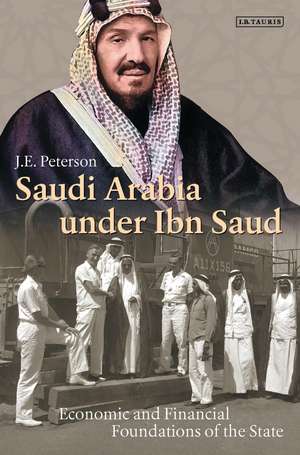Saudi Arabia Under Ibn Saud: Economic and Financial Foundations of the State
Autor J.E. Petersonen Limba Engleză Hardback – 20 iun 2018
Preț: 570.93 lei
Preț vechi: 772.44 lei
-26% Nou
Puncte Express: 856
Preț estimativ în valută:
109.28€ • 113.65$ • 91.57£
109.28€ • 113.65$ • 91.57£
Carte tipărită la comandă
Livrare economică 13-27 martie
Preluare comenzi: 021 569.72.76
Specificații
ISBN-13: 9781784539009
ISBN-10: 1784539007
Pagini: 304
Ilustrații: 2 maps, 4 tables
Dimensiuni: 156 x 234 x 28 mm
Greutate: 0.62 kg
Editura: Bloomsbury Publishing
Colecția I.B.Tauris
Locul publicării:London, United Kingdom
ISBN-10: 1784539007
Pagini: 304
Ilustrații: 2 maps, 4 tables
Dimensiuni: 156 x 234 x 28 mm
Greutate: 0.62 kg
Editura: Bloomsbury Publishing
Colecția I.B.Tauris
Locul publicării:London, United Kingdom
Notă biografică
J.E. Peterson is a historian and political analyst specializing in the Arabian Peninsula. He has taught at various universities including Bowdoin College, the College of William and Mary, the University of Pennsylvania, Portland State University and SciencesPo; and has been associated with a number of leading research institutes in the United States and the United Kingdom. Until 1999, he served in the Office of the Deputy Prime Minister for Security and Defence in Muscat, Sultanate of Oman. He is currently affiliated with the Center for Middle Eastern Studies at the University of Arizona and is the author or editor of a dozen books and monographs, including most recently Historical Muscat: An Illustrated Guide and Gazetteer; Oman's Insurgencies: The Sultanate's Struggle for Supremacy; The GCC States: Participation, Opposition, and the Fraying of the Social Contract; The Emergence of the Gulf States: Studies in Modern History and a third edition of Historical Dictionary of Saudi Arabia.
Cuprins
List of Illustrations Preface Glossary Abbreviations 1. Saudi Arabia in the Twentieth Century The Kingdom of Saudi Arabia Origins of Government Administration and FinancialRequirements PART I FINANCES AND OIL BEFORE WORLD WAR II2. The Organization of State Finances Control of the Treasury in the Early 1920s Control of Finances in al-Hijaz and the Directorate from 1927 Controller of National Finances and the Financial Authority(al-Wikalah) (1927 - 9) Establishment of the Ministry of Finance (1932) Administering Finances During the Great Depression 3. The 1933 Oil Concession and Oil Affairs to World War II Early Oil Exploration in Arabia The Role of Charles Crane and Karl Twitchell The Original 1933 Concession Further Developments in the ARAMCO Concession 4. Early Administrative Arrangements Military and Defense Air and Transport Foreign Affairs Hajj Administration Mining Activities Electricity and Water Supply Other Ministry of Finance Responsibilities PART II THE IMPACT OF WORLD WAR II5. British Wartime Assistance and the Emergence of Anglo-American Rivalry The Inception of British Wartime Subsidies The Kingdom's Dire Internal Situation in 1942 - 3 Issues with the British Subsidy for 1944 The US Supplants British Influence with the 1945 Subsidy 6. The Beginnings of the US - Saudi Partnership The Historic Meeting between King ?Abd al-?Aziz and President Roosevelt Wartime Subsidies and Lend - Lease Assistance Military Provisions and the Dhahran Air Base Agreement 7. Administrative Developments Endeavors in Agriculture Continuing Developments in Foreign Affairs and Defense Banking and Currency Development Projects Miscellaneous Activities PART III POSTWAR PROSPERITY AND ECONOMIC DEVELOPMENT8. Oil Emerges as the Financial Engine Oil Company Relations During the War TAPline and Other Oil Concerns (1946 - 9) Financial Relations between the Saudi Arabian Government and ARAMCO (1946 - 9) Oil Negotiations and Related Matters (1950 - 4) Other Financial Relations between the Saudi Arabian Government and ARAMCO (1950 - 4) Onassis and the SATCO Affair of 1954 9. Postwar Stringencies and the Push for Development (1945 - 9) A New Normalcy After the War Establishing a Controlled Budgetary Process and Spearheading Socioeconomic Development 10. The Broad Remit of the Postwar Ministry of Finance The Establishment of the Saudi Arabian Monetary Agency Mining Activities and Transport Saudi Employees in ARAMCO Agriculture Other Responsibilities 11. The Emergence of Prosperity (1950 - 4) Finances and Currency Reform Development Projects The Expansion of Government Administration The Ministry of Finance in the Transition from King ?Abd al-?Aziz to King Sa?ud Notes Bibliography Index
Recenzii
A very welcome addition to the field. [Peterson's] attention to detail is superb: he provides in-depth analysis of a wide range of financial and economic issues across three decades ... [The] attention to detail, solid source-work, broad scope, and novel focus make this book indispensable to historians of early Saudi Arabia.
Peterson's book is a sobering reminder of living and governing conditions in the days prior to their major impact on state capacity. The book clearly demonstrates the importance of Sulayman in the KSA's early decades.
Peterson's book is a sobering reminder of living and governing conditions in the days prior to their major impact on state capacity. The book clearly demonstrates the importance of Sulayman in the KSA's early decades.
